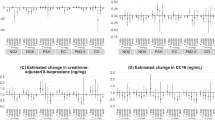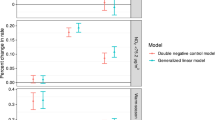Abstract
Objective
To examine relationships between traffic-related air pollution (TRAP) and markers of pre-clinical cardiovascular risk in young children.
Study design
We studied a cohort of healthy children ages 2–5 recruited from pediatric primary care sites (n = 122). We obtained child weight, height, blood pressure and hair nicotine levels. A blood sample was obtained for biomarkers of systemic inflammation, oxidation, and prevalence of circulating endothelial progenitor cells. This manuscript represents a secondary analysis. TRAP exposure (particulate levels, nitrogen dioxide, nitrogen oxides, and proximity to major roadways) was assessed using national air pollution data based on child’s census tract of residence.
Results
TRAP exposure had significant positive associations with prevalence of two of the three EPC subtypes (CD34 + /CD133 + /CD45− and CD133 + /CD45−) in unadjusted correlations. In a linear regression model, adjusting for sex, age, race, ethnicity, body mass index, parental education, child insurance, and secondhand smoke exposure, one EPC subtype (CD133 + /CD45−) had a positive significant correlation to every TRAP measure. No significant relationships between air pollution and measures of inflammation and oxidation was found.
Conclusion
Our findings of the upregulation of EPCs may signal a response to early vascular damage during early childhood due to air pollution exposure.
Impact
-
Traffic-related air pollution (TRAP) - known cardiovascular risk factor during adulthood
-
Current pilot study in very young children shows upregulation of cells which protect the endothelial lining of blood vessels (endothelial progenitor cells, EPCs)
-
Upregulation of EPCs aligns with other cardiovascular risks during childhood (obesity, prematurity, type 1 diabetes)
-
Demonstrated with TRAP exposure lower than EPA threshold
-
Response to air pollution may be protective of cardiovascular damage during early childhood
This is a preview of subscription content, access via your institution
Access options
Subscribe to this journal
Receive 14 print issues and online access
$259.00 per year
only $18.50 per issue
Buy this article
- Purchase on SpringerLink
- Instant access to full article PDF
Prices may be subject to local taxes which are calculated during checkout

Similar content being viewed by others
Data availability
The datasets generated during and/or analyzed during the current study are available from the corresponding author on request.
References
Raghuveer, G. et al. Cardiovascular consequences of childhood secondhand tobacco smoke exposure: prevailing evidence, burden, and racial and socioeconomic disparities: A Scientific Statement From the American Heart Association. Circulation 134, e336–e359 (2016).
Brook, R. D. et al. Particulate matter air pollution and cardiovascular disease: An update to the scientific statement from the American Heart Association. Circulation 121, 2331–2378 (2010).
Boehmer, T. K., Foster, S. L., Henry, J. R., Woghiren-Akinnifesi, E. L. & Yip, F. Y. Residential proximity to major highways - United States, 2010. MMWR Suppl. 62(3), 46–50 (2013).
Traffic-Related Air Pollution: A critical review of the literature on emissions, exposure, and health effects | Health Effects Institute. 2010. Accessed 6/8/21, (2021).
DeJarnett, N. et al. Residential proximity to major roadways is associated with increased levels of AC133+ circulating angiogenic cells. Arterioscler Thromb. Vasc. Biol. 35, 2468–2477 (2015).
Zeka, A., Sullivan, J. R., Vokonas, P. S., Sparrow, D. & Schwartz, J. Inflammatory markers and particulate air pollution: characterizing the pathway to disease. Int J. Epidemiol. 35, 1347–1354 (2006).
Mirowsky, J. E. et al. Repeated measures of inflammation, blood pressure, and heart rate variability associated with traffic exposures in healthy adults. Environ. health 14, 66 (2015).
Hill, J. M. et al. Circulating endothelial progenitor cells, vascular function, and cardiovascular risk. N. Engl. J. Med. 348, 593–600 (2003).
Pires, A. et al. Circulating endothelial progenitor cells in obese children and adolescents. J. de. Pediatr. 91, 560–566 (2015).
Głowińska-Olszewska, B. et al. Relationship between circulating endothelial progenitor cells and endothelial dysfunction in children with type 1 diabetes: a novel paradigm of early atherosclerosis in high-risk young patients. Eur. J. Endocrinol. 168, 153–161 (2013).
Markopoulou, P. et al. Increased circulating endothelial progenitor cells (EPCs) in prepubertal children born prematurely: a possible link between prematurity and cardiovascular risk. Pediatr. Res. 90, 156–165 (2021).
Groner, J. A. et al. Secondhand smoke exposure and preclinical markers of cardiovascular risk in toddlers. J. Pediatr. 189, 155–161 (2017).
Costa, A. & Pasquinelli, G. Air pollution exposure induces vascular injury and hampers endothelial repair by altering progenitor and stem cells functionality. Front. cell Developmental Biol. 10, 897831 (2022).
Singh, P., O’Toole, T. E., Conklin, D. J., Hill, B. G. & Haberzettl, P. Endothelial progenitor cells as critical mediators of environmental air pollution-induced cardiovascular toxicity. Am. J. Physiol. Heart Circulatory Physiol. 320, H1440–H1455 (2021).
Cui, Y., Sun, Q. & Liu, Z. Ambient particulate matter exposure and cardiovascular diseases: a focus on progenitor and stem cells. J. Cell. Mol. Med. 20, 782–793 (2016).
Bateson, T. F. & Schwartz, J. Children’s response to air pollutants. J. Toxicol. Environ. Health Part A. 71, 238–243 (2008).
Brumberg, H. L. & Karr, C. J. Ambient air pollution: Health hazards to children. Pediatrics 47, e2021051484 (2021).
Hoffman, R. P., Dye, A. S., Huang, H. & Bauer, J. A. Effects of glucose control and variability on endothelial function and repair in adolescents with type 1 diabetes. ISRN Endocrinol. 2013, 876547 (2013).
University of North Carolina Institute for the Environment. 2018. Community Modeling and Analysis System. 2018; https://www.cmascenter.org/c-tools/c-line.cfm.
United States Environmental Protection Agency. 2017. EJSCREEN. (Accessed 07/07/21), at EJScreen: Environmental Justice Screening and Mapping Tool | US EPA
Environmental Sciences Research Institute, ArcGIS. Version 10.7.1, 2010, acc United States Environmental Protection Agency. 2017. EJSCREEN.
Agency USEP. Primary National Ambient Air Quality Standards (NAAQS) for Nitrogen Dioxide 2018; https://www.epa.gov/no2-pollution/primary-national-ambient-air-quality-standards-naaqs-nitrogen-dioxide. Accessed 6/4/2023.
Rigato, M., Avogaro, A. & Fadini, G. P. Levels of circulating progenitor cells, cardiovascular outcomes and death: a meta-analysis of prospective observational studies. Circ. Res. 118, 1930–1939 (2016).
O’Toole, T. et al. Episodic exposure to fine particulate air pollution decreases circulating levels of endothelial progenitor cells. Circ. Res. 107(2), 200–203 (2010).
Niu, J. et al. The role of metal components in the cardiovascular effects of PM2.5. PloS One 8, e83782 (2013).
Brook, R. D. et al. The effect of acute exposure to coarse particulate matter air pollution in a rural location on circulating endothelial progenitor cells: results from a randomized controlled study. Inhal. Toxicol. 25, 587–592 (2013).
Jantzen, K. et al. Exposure to ultrafine particles, intracellular production of reactive oxygen species in leukocytes and altered levels of endothelial progenitor cells. Toxicology 359, 11–18 (2016).
Armijos, R. X. et al. Residential exposure to urban traffic is associated with increased carotid intima-media thickness in children. J. Environ. Public Health 2015, 713540 (2015).
Iannuzzi, A. et al. Air pollution and carotid arterial stiffness in children. Cardiol. Young. 20, 186–190 (2010).
Kelishadi, R. et al. Effect of particulate air pollution and passive smoking on surrogate biomarkers of endothelial dysfunction in healthy children. Paediatrics Int. Child Health 34, 165–169 (2014).
Stein, A. et al. Circulating endothelial progenitor cells decrease in patients after endarterectomy. J. Vasc. Surg. 48, 1217–1222 (2008).
Groner, J. A., Joshi, M. & Bauer, J. A. Pediatric precursors of adult cardiovascular disease: noninvasive assessment of early vascular changes in children and adolescents. Pediatrics 118, 1683–1691 (2006).
Xiao, J. et al. Toxicological effects of traffic-related air pollution on the lungs: Evidence, biomarkers, and intervention. Ecotoxicol. Environ. Saf. 238, 1–6 (2022).
Skilton, M. R. & Celermajer, D. S. Endothelial dysfunction and arterial abnormalities in childhood obesity. Int. J. Obes. 30, 1041–1049 (2006).
Bruyndonckx, L., Hoymans, V. Y., Lemmens, K., Ramet, J. & Vrints, C. J. Childhood obesity-related endothelial dysfunction: an update on pathophysiological mechanisms and diagnostic advancements. Pediatr. Res. 79, 831–837 (2016).
Juonala, M. et al. Parental smoking in childhood and brachial artery flow-mediated dilatation in young adults: the Cardiovascular Risk in Young Finns study and the childhood ceterminants of adult health study. Arterioscler Thromb. Vasc. Biol. 32, 1024–1031 (2012).
Tian, N., Xue, J. & Barzyk, T. M. Evaluating socioeconomic and racial differences in traffic-related metrics in the United States using a GIS approach. J. Expo. Sci. Environ. Epidemiol. 23, 215–222 (2013).
Acknowledgements
We acknowledge Tiasha Letostak PhD for her help making the collaboration which led to this work possible. This work was supported in part by the American Academy of Pediatrics Julius B. Richmond Center of Excellence, (Groner & Bauer, Co-PIs), which is funded by grants from the Flight Attendant Medical Research Institute and Legacy. Other support also included the US National Institutes of Health (R21ES016883) and the University of Kentucky Center for Appalachian Research in Environmental Sciences (P30ES026529) and the Regina Drury Pediatric Research Endowment Fund (Bauer). The support for the secondary analysis was from the Nationwide Children’s Hospital Primary Care Affinity Group. The findings and conclusions are those of the authors and do not necessarily represent the official position of any of these institutions. The sponsors had no role in study design, data collection, analysis, and interpretation, writing this report or the decision to submit this report for publication.
Author information
Authors and Affiliations
Contributions
The authors have met the Pediatric Research authorship requirements. Substantial contributions to conception and design, acquisition of data, or analysis and interpretation of data: Groner, Nicholson, Bauer, Huang, Lindstrom, Root. Drafting the article or revisit it critically for important intellectual content: Groner, Nicholson, Bauer, Lindstrom. Final approval of the version to be published: Groner, Nicholson, Bauer, Huang, Lindstrom, Root.
Corresponding author
Ethics declarations
Competing interests
The authors declare no competing interests.
Ethical approval
The Nationwide Children’s Hospital (NCH) IRB approved of the original study (IRB11-00437). The secondary analysis was deemed to be IRB exempt by the NCH IRB.
Additional information
Publisher’s note Springer Nature remains neutral with regard to jurisdictional claims in published maps and institutional affiliations.
Rights and permissions
Springer Nature or its licensor (e.g. a society or other partner) holds exclusive rights to this article under a publishing agreement with the author(s) or other rightsholder(s); author self-archiving of the accepted manuscript version of this article is solely governed by the terms of such publishing agreement and applicable law.
About this article
Cite this article
Groner, J.A., Nicholson, L., Bauer, J.A. et al. Exposure to air pollution and cardiovascular risk in young children – a pilot project. Pediatr Res 96, 1718–1723 (2024). https://doi.org/10.1038/s41390-024-03377-z
Received:
Revised:
Accepted:
Published:
Issue date:
DOI: https://doi.org/10.1038/s41390-024-03377-z



